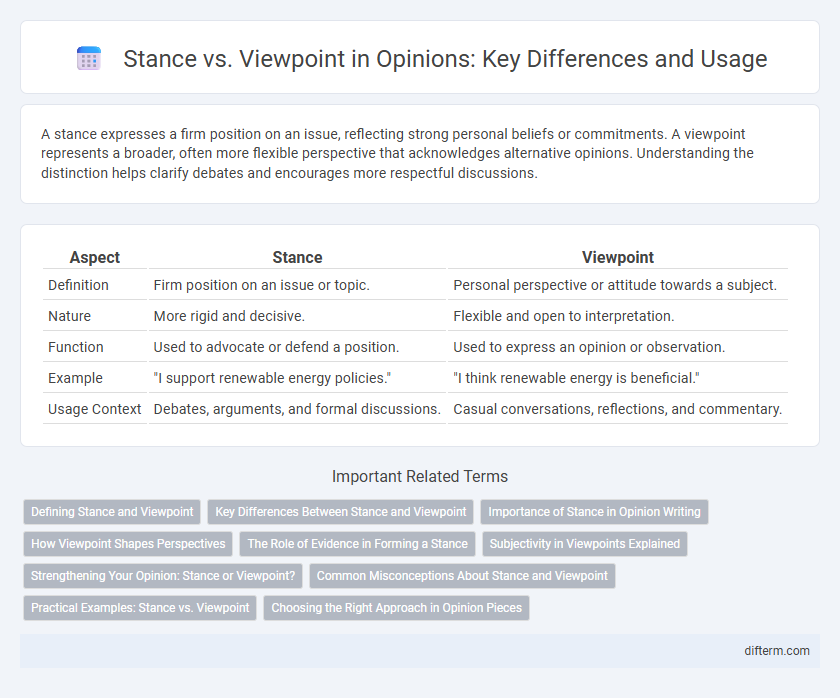A stance expresses a firm position on an issue, reflecting strong personal beliefs or commitments. A viewpoint represents a broader, often more flexible perspective that acknowledges alternative opinions. Understanding the distinction helps clarify debates and encourages more respectful discussions.
Table of Comparison
| Aspect | Stance | Viewpoint |
|---|---|---|
| Definition | Firm position on an issue or topic. | Personal perspective or attitude towards a subject. |
| Nature | More rigid and decisive. | Flexible and open to interpretation. |
| Function | Used to advocate or defend a position. | Used to express an opinion or observation. |
| Example | "I support renewable energy policies." | "I think renewable energy is beneficial." |
| Usage Context | Debates, arguments, and formal discussions. | Casual conversations, reflections, and commentary. |
Defining Stance and Viewpoint
Stance refers to a firm position or attitude someone holds toward a particular issue, often reflecting underlying beliefs and values, whereas viewpoint is a more general perspective or opinion that may be flexible and subject to change. Defining stance involves identifying explicit commitments and motivations behind an expression, while defining viewpoint emphasizes the interpretation and framing of information from an individual's angle. Understanding the distinction between stance and viewpoint is crucial for analyzing argumentation and communication in opinion-based discourse.
Key Differences Between Stance and Viewpoint
Stance refers to a firm position or attitude adopted on a particular issue, reflecting a person's commitment and often influencing their actions or arguments. Viewpoint, however, represents an individual's perspective or opinion shaped by personal experiences and knowledge, which may be more flexible or open to change. Key differences between stance and viewpoint lie in the level of certainty and the intent behind them, where stance implies a stronger, more declared position while viewpoint suggests a broader, interpretive angle.
Importance of Stance in Opinion Writing
Stance in opinion writing anchors the argument by clearly identifying the writer's position, providing a foundation for persuasive and coherent discourse. A well-defined stance ensures the audience understands the writer's perspective, enhancing the impact and clarity of the opinion. Emphasizing stance over mere viewpoint strengthens argumentative effectiveness and guides readers through logical reasoning.
How Viewpoint Shapes Perspectives
A viewpoint functions as a lens through which individuals interpret experiences, heavily influencing their understanding and reactions. It molds cognitive biases and emotional responses, leading to diverse perspectives even on identical issues. Recognizing this dynamic underscores the importance of examining differing viewpoints to foster empathy and comprehensive analysis.
The Role of Evidence in Forming a Stance
A well-formed stance relies heavily on credible evidence, distinguishing it from a mere viewpoint that may be shaped by personal bias or limited information. Evidence-based stances incorporate data, facts, and verified sources to support the position, ensuring it withstands critical analysis and debate. This reliance on evidence enhances the persuasiveness and legitimacy of the stance in any discussion or argument.
Subjectivity in Viewpoints Explained
Viewpoints emphasize subjectivity by reflecting personal experiences, emotions, and cultural backgrounds that shape individual perspectives. Unlike stances, which often imply a fixed position or judgment, viewpoints allow for fluid interpretations and nuanced understanding of complex issues. This subjectivity highlights the diverse ways people perceive and engage with ideas, fostering open dialogue and empathy.
Strengthening Your Opinion: Stance or Viewpoint?
Focusing on a clear stance sharpens the argument by presenting a definitive position, enhancing persuasive impact and reader engagement. A well-defined viewpoint adds depth by acknowledging complexity, allowing nuanced discussion without diluting conviction. Combining a strong stance with a thoughtful viewpoint encourages balanced reasoning and strengthens the overall opinion.
Common Misconceptions About Stance and Viewpoint
Common misconceptions about stance and viewpoint often confuse the two, but stance refers to a speaker's explicit position on an issue, while viewpoint encompasses broader perspectives shaped by personal experiences and beliefs. Stance is typically expressed through clear language cues indicating agreement, disagreement, or neutrality, whereas viewpoint includes underlying values and cultural contexts influencing interpretation. Understanding this distinction is crucial for accurately analyzing opinions in discourse and avoiding oversimplification.
Practical Examples: Stance vs. Viewpoint
A stance represents a firm position on an issue, often influenced by personal values or beliefs, while a viewpoint reflects an individual's perspective shaped by experiences or knowledge. For example, a person's stance on climate change might be advocacy for renewable energy, whereas their viewpoint could include the economic impacts of such policies. Understanding these distinctions helps clarify debates by highlighting whether opinions stem from unwavering commitments or situational interpretations.
Choosing the Right Approach in Opinion Pieces
Choosing between stance and viewpoint in opinion pieces shapes the depth and clarity of the argument. A stance conveys a clear, often polarized position that drives persuasive impact, while a viewpoint explores multiple perspectives to foster understanding and nuance. Prioritizing a stance enhances decisiveness and reader engagement, whereas emphasizing a viewpoint encourages critical thinking and balanced discussion.
stance vs viewpoint Infographic

 difterm.com
difterm.com